Introduction:
The American Foxhound was developed in United States. It is a hound breed. Especially used for fox trailing. The life span of the American Foxhound is 12-13 years. It is also called as Foxhound as its nickname.

Origin / History:
The American Foxhound is an energetic, easy going and friendly dog. The American Foxhounds can be stubborn and independent which causes difficulty in training and takes patience. It is difficult to make them understand that it is not necessary to bark at some people. They howl in a quite loud voice. They have a very good sense of smell. The American Foxhounds don’t run off but are clever enough to figure out how gates latch. So do not leave them off the leash, unless you are sure that there are no roads anywhere.
Physical Appearance:
The height of American Foxhound is 21-25 inches (53-64 cm) and the weight is 65-75 pounds (29-34 kg). The American Foxhound is a large, powerful and medium size dog. The color of the breed is white, black and tan. The head is long and broad. The eyes are large and brown in color. The nose is black in color. The dropped ears are of medium length. The legs are long and straight. The tail is curved and set high.
Health Concerns:
The American Foxhound is generally a healthy breed. American Foxhounds are free of many genetic diseases such as hip and bone problems, which plague other large breeds. They gain weight easily, so do not over feed them.
Grooming:
Weekly brushing is needed. Regular vigorous exercise is recommended to this breed. They should be taken on daily walk, jog and run.
Cost:
The cost of purchasing this breed is $ 400 USD
Advantages:
Disadvantages:
The American Foxhound was developed in United States. It is a hound breed. Especially used for fox trailing. The life span of the American Foxhound is 12-13 years. It is also called as Foxhound as its nickname.

Origin / History:
- The American Foxhound was brought by Robert Brooke in early 1650
- The American Foxhound was the first domesticated dog in America
- The American Foxhound has actually been named as the official state animal
- It is recognized in the common studbooks that the Brooke dogs were distinctly separate line from other dogs
The American Foxhound is an energetic, easy going and friendly dog. The American Foxhounds can be stubborn and independent which causes difficulty in training and takes patience. It is difficult to make them understand that it is not necessary to bark at some people. They howl in a quite loud voice. They have a very good sense of smell. The American Foxhounds don’t run off but are clever enough to figure out how gates latch. So do not leave them off the leash, unless you are sure that there are no roads anywhere.
Physical Appearance:
The height of American Foxhound is 21-25 inches (53-64 cm) and the weight is 65-75 pounds (29-34 kg). The American Foxhound is a large, powerful and medium size dog. The color of the breed is white, black and tan. The head is long and broad. The eyes are large and brown in color. The nose is black in color. The dropped ears are of medium length. The legs are long and straight. The tail is curved and set high.
Health Concerns:
The American Foxhound is generally a healthy breed. American Foxhounds are free of many genetic diseases such as hip and bone problems, which plague other large breeds. They gain weight easily, so do not over feed them.
Grooming:
Weekly brushing is needed. Regular vigorous exercise is recommended to this breed. They should be taken on daily walk, jog and run.
Cost:
The cost of purchasing this breed is $ 400 USD
Advantages:
- The American Foxhound gets along with everyone, including children and other dogs
- They are very social dogs
Disadvantages:
- The American Foxhounds do not make good watch dogs
- They become destructive in loud noises and overwhelming situations


















